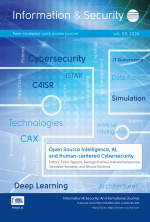Top downloads
| Title | Downloads |
|---|---|
Islamic State’s Incursion into North Africa and Sahel: A Threat to al-Qaeda? |
(159) |
Islamic State in Yemen – A Rival to al-Qaeda? |
(148) |
Islamic State Enters Al-Qaeda’s Old Hotbed: Afghanistan and Pakistan |
(170) |
Heirs of Abu Bakr: On the Ideology and Conception of History in al-Qaeda and Islamic State |
(160) |
The Mole and the Mallet: Islamic State and al-Qaeda in the ‘Thirty Years’ War’ in the Middle East |
(199) |
Disunity in Global Jihad: A Preface |
(182) |
A Euro Border Guard and Hybrid Warfare. An Art Theft Perspective: Human Dimensions and a Moral Imperative |
(145) |
The Rise and Consolidation of Islamic State: External Intervention and Sectarian Conflict |
(154) |
Towards More Effective Cooperation? The Role of States in Shaping NATO-EU Interaction and Cooperation |
(171) |
From Wales to Warsaw and Beyond: NATO’s Strategic Adaptation to the Russian Resurgence on Europe’s Eastern Flank |
(215) |
A Changing Security Paradigm. New Roles for New Actors – The Russian Approach |
(218) |
NATO Nuclear Deterrence: The Warsaw Summit and Beyond |
(185) |
The Mobilization and Recruitment of Foreign Fighters: The Case of Islamic State, 2012–2014 |
(150) |
Terrorism and Organized Crime |
(204) |
Cyberspace as the Environment Affected by Organized Crime Activity |
(170) |
Maritime Piracy as a Form of Organized Crime: A Strategic Management Approach |
(157) |
Transnational Organized Crime – Latvian Challenges and Responses |
(154) |
Global Dimensions of Organized Crime and Ways of Preventing Threats at International Level |
(199) |
Karachi: Organized Crime in a Key Megacity |
(154) |
Cyber Operations and Gray Zones: Challenges for NATO |
(419) |
Non-State Actors in the Russo-Ukrainian War |
(163) |
Making Sense of Hybrid Warfare |
(276) |
Hybrid Warfare and the Changing Character of Conflict |
(135) |
Biology’s Misuse Potential |
(136) |
Nanotechnology and Global Security |
(143) |
Industry and Policy: Partnerships in Disruptive Times |
(168) |
Policy and the Internet of Things |
(403) |
Emerging Security Challenges: An Introduction |
(104) |
The Rise of Intelligence Studies: A Model for Germany? |
(148) |
The Relevance of Clausewitz’s Theory of War to Contemporary Conflict Resolution |
(181) |
‘Good’ and ‘Bad’ Investments: Everything You Always Wanted to Know about Ukrainian Commanders but Were Afraid to Ask |
(176) |
Torn Asunder from Within: Ukraine and the Lessons for Global Security |
(141) |
The Threats and Challenges of a Multipolar World: A Ukraine Crisis Case Study |
(173) |
Beyond Propaganda: Soviet Active Measures in Putin’s Russia |
(242) |
GAO Report on Combating Terrorism |
(109) |
The Terrorist Threats Against Russia and its Counterterrorism Response Measures |
(142) |
NATO SeaSparrow Program: Cooperation Based on Trust |
(137) |
Conflict in Kosovo through the Conceptual Framework of Stakeholders |
(116) |
Kosovo 1999 and Crimea 2014: Similarities and Differences |
(134) |
A Look Back at NATO’s 1999 Kosovo Campaign: A Questionably "Legal" but Justifiable Exception? |
(144) |
How Russia, Step by Step, Wants to Regain an Imperial Role in the Global and European Security System |
(189) |
Strategic Implications of the War in Ukraine for the Post-Soviet Space: A View from Central Asia |
(157) |
Central Asian Stances on the Ukraine Crisis: Treading a Fine Line? |
(177) |
Gender Mainstreaming of the Security Sector in Bosnia and Herzegovina: From the Policy Papers to Reality |
(119) |
The Bundeswehr and Female Soldiers: The Integration of Women into the Armed Forces (2000–2015) |
(125) |
Begging the Question: What Would a Men, Peace and Security Agenda Look Like? |
(102) |
What Role for the Security Sector? An SSR Approach to Implementing the Women, Peace and Security Agenda |
(108) |
Gender and the Security Sector: Towards a More Secure Future |
(140) |
NATO and the Women, Peace and Security Agenda: Time to Bring It Home |
(103) |
Return to Babel: The Race to Integration in the Southern Caucasus |
(90) |
